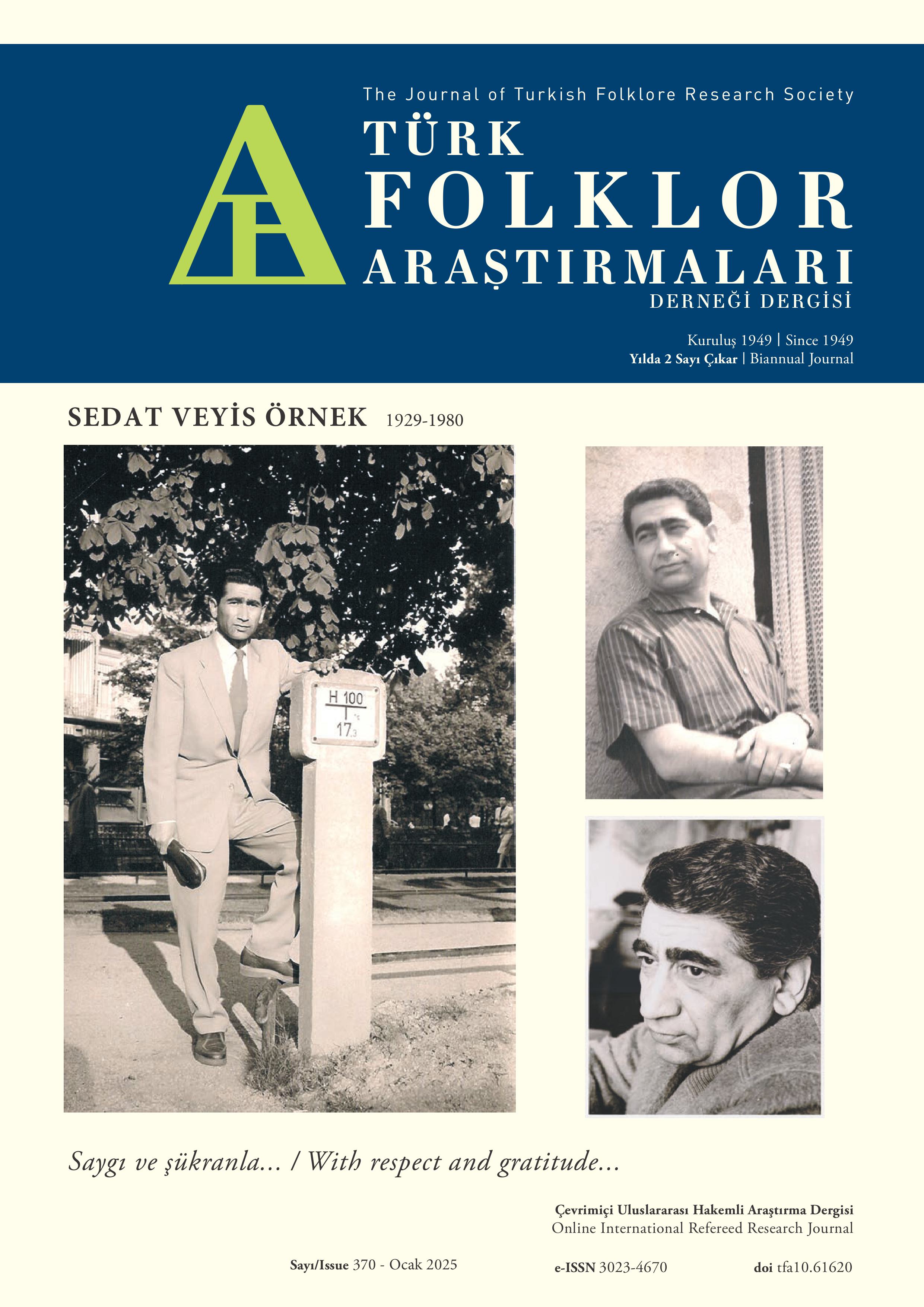Âşık Mustafa Aydın’dan Derlenen Arzu ile Kamber Hikâyesinin İncelemesi
DOI:
https://doi.org/10.61620/tfa.50Anahtar Kelimeler:
Âşık Mustafa Aydın, âşıklık geleneği, halk hikâyesi, varyant, Arzu ile KamberÖzet
Yüzyıllar aşıp gelen halk hikâyeleri çeşitli rol ve işlevleriyle, kültürün bir parçası olarak uzun süre varlığını sürdürmüştür. Son dönemlerde canlılığını yitirmiş olsa da hâlâ Doğu Anadolu bölgesi özellikle Kars, Erzurum gibi illerde geleneğin kısmen yaşatıldığını görmek mümkündür. Geleneğin icracılarından ve temsilcilerinden olan âşıklar, hikâye oluşturma ve anlatma geleneğini koruma ve geleneği nesillere aktarma görevini üstlenmişlerdir. Bu düşünceden hareketle yaşayan âşıklardan Âşık Mustafa Aydın’ın hikâye anlatma geleneği içindeki yerini değerlendirmek ve varyantlaşmasına katkıda bulunduğu Arzu ile Kamber hikâyesini incelemek çalışmanın temel amaçlarındandır. Bu bağlamda; Âşık Mustafa Aydın’ın hikâye oluşturma, anlatma ve aktarma geleneğindeki önemi üzerinde yoğunlaştım. Çalışma kapsamında motif ve epizot yapılarını incelemek amacıyla Esma Şimşek’in “Arzu ile Kamber Hikâyesi Üzerinde Mukayeseli Bir Araştırma” adlı yüksek lisans tezinde geçen dört numaralı sözlü varyant, Âşık Mevlüt İhsanî’ye ait hikâye ve Ali Berat Alptekin’in “Halk Hikâyelerinin Motif Yapısı” isimli kitabındaki otuz altı numaralı Arzu ile Kamber hikâyesi ile ilgili kısa bir açıklama yaparak, bu varyantların kendi aralarındaki farkları açıklamaya çalıştım. Böylelikle kendisine ait altı hikâyesi olan âşığın Arzu ile Kamber anlatısının bilinen hikâyeden farklı olduğu inceleme, tahlil ve karşılaştırmalar neticesinde tespit edilmiştir. Hikâyenin farklı anlatıcı tarafından yorumlanması, halk hikâyelerinin yaşayan bir kültürel değer olduğunu ortaya koymakla birlikte Âşık Mustafa Aydın’ın anlatımı, deneyimleri ve âşıklık geleneğindeki eğitimi hikâyeye özgün bir dokunuş katmıştır.
Referanslar
Alptekin, A. B. (2021). Halk hikâyelerinin motif yapısı. Akçağ.
Altan, D. (2007). Mustafa Aydın’ın hayatı, sanatı ve şiirleri. [Yüksek lisans tezi]. Gazi Üniversitesi.
Başgöz, İ. (1986). Folklor yazıları. Adam.
Boratav, P. N. (2015). 100 soruda Türk halk edebiyatı. Bilgesu.
Boratav, P. N. (2020). Halk hikâyeleri ve halk hikâyeciliği. Bilgesu.
Uğur Çerikan, F., & Kazancı, S. (2020). Arzu ile Kamber hikâyesinin yeni bir varyantı ve çözümlemesi. Avrasya Uluslararası Araştırmalar Dergisi, 8 (23), 20-44.
Duymaz, A. (2001). Kerem ile Aslı hikâyesi üzerinde mukayeseli bir araştırma. Kültür Bakanlığı.
Duymaz, A. (2014). 120. Yılında halk hikâyesi araştırmaları tarihine bir bakış. Akademik Kaynak, 2 (3), 1-23.
Düzgün, D. (2018). Sözlü gelenekteki âşık tarzı halk hikâyelerinin yapısı. Atatürk Üniversitesi Edebiyat Fakültesi Dergisi, 61. 255-271.
Elçin, Ş. (2019). Halk edebiyatına giriş. Akçağ.
Günay, U. (2011). Türkiye’de âşık tarzı şiir geleneği ve rüya motifi. Akçağ.
İnan, A. (1998). Makaleler ve incelemeler I-II. Türk Tarih Kurumu.
Sakaoğlu, M. (2021). Türk halk hikâyeleri ve halk hikâyelerinde efsane motifleri. Akçağ.
Şimşek, E. (1987). Arzu ile Kamber hikâyesi üzerinde mukayeseli bir araştırma. [Yayınlanmamış Yüksek Lisans Tezi]. Fırat Üniversitesi.
Türkmen, F. (2015). Tahirile Zühre (inceleme-metin). Atatürk Kültür Merkezi Başkanlığı. Türkmen, F., & Cemiloğlu, M. (2020). Âşık Mevlüt İhsanî’ den derlenen halk hikâyeleri. Türk Dil Kurumu.
İndir
Yayınlanmış
Nasıl Atıf Yapılır
Sayı
Bölüm
Lisans
Telif Hakkı (c) 2025 tuğçe coşkun

Bu çalışma Creative Commons Attribution 4.0 International License ile lisanslanmıştır.



